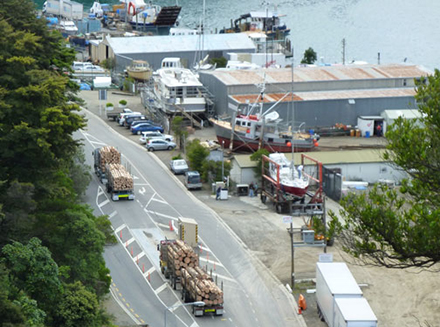
Nelson’s logging carriers say three-hour waits and queues of up to 40 trucks at Port Nelson is costing them and exporters time and money. Source: Stuff NZ
An estimated 30% increase in overseas demand for New Zealand logs in the last year has put pressure on available resources at the port, with carriers saying a lack of space is causing chaos for log trucks.
The port says it is aware of the problem and aims to spend $8m working on improving the efficiency of log unloading and storage.
Prior to the start of port redevelopments in 2016, including construction of a 13,000 square-metre wine warehouse, carriers had three log yards available to them on Wildman Ave, Low St and off Rogers St.
Logging storage has since been brought inside the port’s operational area. The resulting concentration of trucks has prompted a call for more lanes or longer hours for the log yard.
Waimea Contract Carriers executive director Jenny McIntyre said the problem had been ongoing problem “off and on” for around three years but had been exacerbated by the market being so good as well as the lay out changes to Port Nelson.
“It’s a case of having a lot of demand for our service and having a lot of time sitting down there – I said to one of our forest owners that effectively we could have carted 72 more loads for them last month.”
McIntyre said wait times for trucks had been up to three hours and cost the company $1 for each minute a truck unit was waiting.
She was aware of queues of up to 40 trucks waiting to unload on some occasions. They worked out their rate based on trucks taking 50 minutes to be processed.
“We’ve only got GPS in 25 of our trucks and we had waited 214 hours over and above [the model time] for the month – that only represented 58% of our trucks down there.”
Based solely on that portion of its fleet, the company would have lost at least $12,840 in labour due to waiting times over that period.
“Not only are we paying labour costs, you’re looking at having to carry the same sort of volume that those trucks are capable of if they were used efficiently – it’s a $500,000 spend to add units which is not necessary.”
As well as additional storage space, McIntyre said having more room for unchaining trailer units would be helpful in alleviating the backlog.
“In a world where we’re all trying to be more efficient and we’ve got the ability to cart more weight on our trucks, the idea is to have less truck movements on the road – if we’re parked down there and not being processed quickly well then effectively you actually need more trucks to cart the same volume.”
McIntyre said the costs incurred were currently being absorbed by the log carriers, not the port or the forest owners, although it was likely to be passed on in the next contract round.
“At the moment why would they [pay more] when we’re carrying the can?” McIntyre said.
She anticipated any change to cost would make raw logs even more expensive for struggling local mills, which had to compete with export log prices.
Port Nelson chief executive Martin Byrne said there had been ongoing discussions with log exporters and C3, who handle the log marshalling in the Port, regarding a number of concerns including truck waiting times and overall space constraints.
“We fully understand and respect the frustrations that exporters have currently and are trying to assist these as best we can, while also working within the reality that there is only limited available space within the Port area.”
Byrne rejected the suggestion of any infrastructure oversight, saying plans had been in place “for a number of years” to make the area available for port-related warehousing while bringing the bulk of log storage inside the operational area.
In order to achieve this Port Nelson spent $4 million in acquiring former road land from Nelson City Council, developing land and investing in six metre steel ‘book-ends’ to enable higher stacking of logs.
Further demolition and sealing work was scheduled in the coming months which, when complete, would see around $8 million spent on log storage areas.
He said the former Low Street log site, where the Patterson Logistics Centre was now located, was limited in its capacity as it was bounded on three sides by public roads, significantly restricting the height of log storage.
There were also considerable ongoing environmental issues with dust from those areas affecting businesses on Vickerman St and boats in the Marina.







